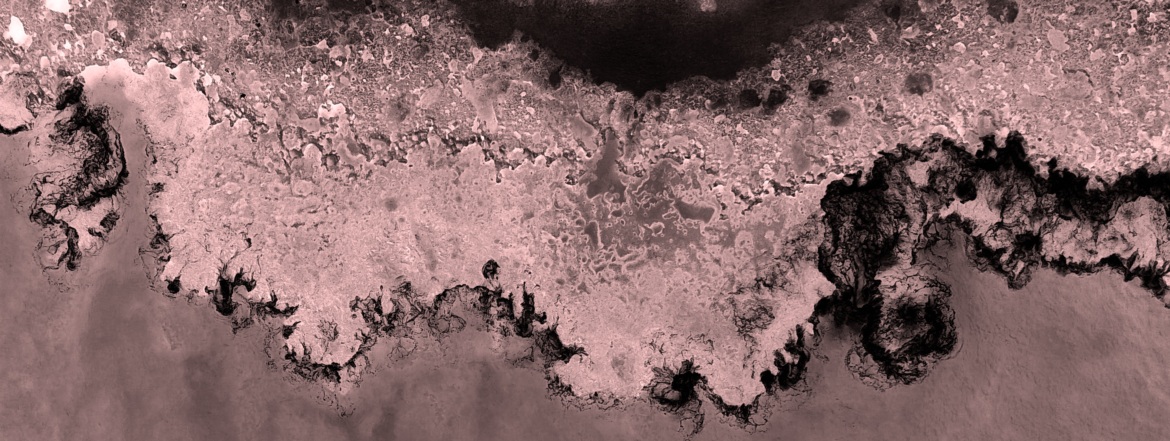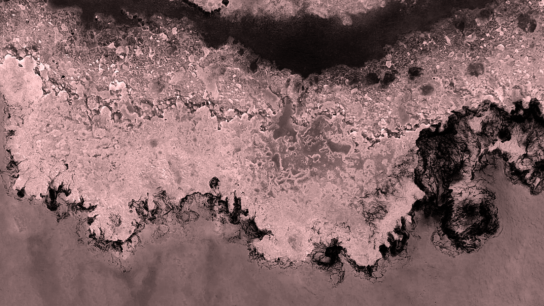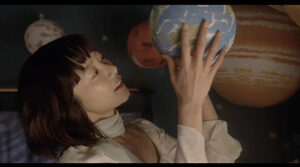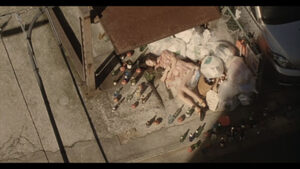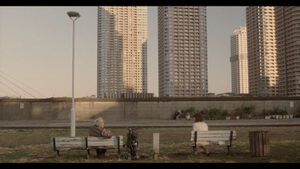Living as if We Were Air Dolls: Theory from the South-East
by
This paper arose from a meeting of UCHRI’s Asia Theories Network, entitled “Island Life.” More papers from the “Island Life” meeting will be released on Foundry over the course of the 2019-2020 academic year.
It is possible that the problem now concerns the one who believes in the world, and not even in the existence of the world but in its possibilities of movements and intensities, so as once again to give birth to new modes of existence, closer to animals and rocks. It may be that believing in this world, in this life, becomes our most difficult task, or the task of a mode of existence still to be discovered on our plane of immanence today.
In What is Philosophy, Deleuze and Guattari argue that our present task now is not so much to believe in the existence of this world as in the possibilities of life; what I understand to be a new proximity to things, “closer to animals and rocks,” when ontology replaces metaphysics, and belief is the dictate of truth. The credo of geophilosophy enjoins us to start thinking from our present planetary situation, to believe in this world even as or precisely because it is withering away, and in this process to learn how to live as if we were planetary beings. Geophilosophy as such is both a critical and reparative practice of this world and in particular of neoliberal societies and the ideology of Western modernism on which they rely. And this why it needs to start from the South/East. I propose in this short essay to think of our planetarity in terms of atmospheres coming from the South/East populated by singular elemental beings: by air dolls. I understand the air doll as an allegory of our planetary existence, hovering at the surface of a spectacle it cannot enter, a leaking subject essentially unsustainable as a form unless supported by a wind blowing from the South/East. In order to articulate this particular figure of the planetary, I bring together two texts: Deleuze’s reading of Michel Tournier’s 1967 novel Friday or, The Other Island in The Logic of Sense, and Koreeda Hirokazu’s 2009 movie Air Doll (kūki ningyo).
I understand the call to believe in this world as a therapeutic gesture, which aims to displace the modernist ethos of individual alienation, nostalgic be-longing, and orientalist desire for the other onto a planetary image populated by aerial being and atmospheric movements. This world we are called into loving, for belief is an act of love (if an impersonal one), is a world without others, where subjects are not defined by a structure of otherness positing the individual as alienated from the self, the world and others but rather by an elemental figure of mediation, a pathic subject – as I suggest in my conclusion, the air doll can function as such a figure. It is not surprising then that the island becomes the theoretical place par excellence from which to start thinking about our planetary situation. And Daniel Defoe’s Robinson is in that respect the position to part with. What is Philosophy? thus really starts by asking “What is an Island?” What is the islandic place in which we can take refuge to turn the modernist alienated subject into a planetary subject and learn to dwell in a new proximity to things, and in increasingly toxic planetary atmospheres? Second, to start from the island is also to start from the urban, for Defoe’s islands are all mirror-images of the particular urban form that holds Western modernity and its alienated subjects. I propose then to figure the island as a littoral city populated by urban subjects not defined by lack and nostalgia for the lost past but rather by leakages; by leaking subjects dwelling in leaking places – air dolls and island-refugees.
Third, if geophilosophy is a therapeutic practice that departs from Western modernist subjectivities, it must start from another image of thought from the South/East. Western modernism has become the ideology of our neoliberal times, hiding our participation in planetary atmospheres behind the façade of entrepreneurial subjects. The neoliberal ethos is premised on the alienation of the subject from the atmospheric background from which it emerges, because the neoliberal subject must believe that it is only responsible to itself. This is why Western modernity remains such a powerful ideological force mobilized to contain the new potentialities of our planetary time, and why it becomes imperative to bring back our planetary atmospheres to the surface where they have always been, to displace the paranoid image of alienated and nostalgic subjects who must strive for survival onto a more reparative figure of subjectivity. Fourth, this becomes then a question of aesthetics, of a possibility of fantasying our planetary situation in the image of a beautiful place rather than the non-place of the sublime that defines the Western modernist subject. The aesthetic of the sublime is too easily appropriated by the state to ground a subject necessarily alienated from this world because this alienation is what secures the boundaries of the national modernist self. The beautiful on the other hand is subversive of this use of the sublime because it is grounded in the social and the ethical belief in the social participation of/with others. The credo of geophilosophy thus leads me to think our planetary situation from the South/East is not so much a place as an orientation in thought that subverts the modernist ideology of neoliberalism – for modernism has become the ideology of the neoliberal ethos.
A good place from which to think of these planetary atmospheres as coming from the South/East is Koreeda Hirokazu’s 2009 movie Air Doll (kūki ningyo). The movie starts with Hideo, a middle-aged office worker, in a bus bound for Tsukishima in the Tokyo Bay where he lives alone. After buying a lunch in the local convenience store, he returns home where Nozomi, an air doll, waits for him. The bus ride and the location of the apartment in the old neighborhood of Tsukishima on the waterfront already articulates the thematic of urban alienation, atmospheric circulation, and life-giving. The walls of Hideo’s room are covered with photographies of space; inflated planets hang from the ceiling and a small telescope is set near the window. The question of urban dwelling for Hideo is a question of mediation between a local place and a planetary space, the local being localized at the intersection of the old (Tsukishima) and the new (the Mori towers in Ishikawajima), in an island between the Sumida river and the Tokyo bay. Nozomi, whose name means hope in Japanese, comes to life after her owner calls her beautiful, kirei. Played by the Korean actress Bae Doona (fig. 1), Nozomi is brought to life more by the call of the beautiful than the judgement of the master – the theme of paternity is explored and rejected in the movie and replaced with the beautiful as an atmospheric movement between beings, places and things. In the 2009 special issue of the journal Yuriika on the Korean actress Bae Duuna, the movie critic Kitakōji Takashi reads this movie as a subversive allegory of commodity fetishism. The air doll’s rejection of her use value as a sex toy exemplifies the resistance of commodities to the logic of commodity fetishism and potentially opening up toward other forms of exchange and circulation.
Figure 1. Ban Duuna playing Nozomi
Air Doll stages the fantasy of urban everyday life by displacing the 1990s modernist trope of urban alienation onto a question of urban pneumatics, of empty bodies in which circulate a planetary urban atmosphere. The question of urban life in Air Doll becomes a question of how to dwell in this space of movement as a medium, an empty receptacle, and how in sharing this planetary atmosphere, they can live together without losing one’s sense of self. Or more simply, how to care for the self in an ongoing state of planetary change. This is also then an allegory of East Asian regionalism making us wonder if cosmopolitanism can still be a viable option for regionalism, and whether we do not need other figures of the urban, such as the littoral city I alluded to earlier. Air Doll makes visible urban atmospheres as both a social lubricant and an oppressive air; both complicit with neoliberalism and always leaking into other social formations because opened to a planetary movement coming from the South/East. Revisiting the creation myth of the human as pneumatic being, Kore-eda’s movie also questions the cinematic dream of modern urban society, an egalitarian society of anonymous individuals animated by the same atmosphere that moves objects, humans and planets. In a fascinating scene, the body of the air doll is juxtaposed with planetary bodies, as Nozomi plays with the plastic balls, suspended in mid-air (fig. 2). The association of a feminine body with planets and the earth returns us to a conservative image of Mother Earth. Yet, what is unexpected is the continuity affirmed between planets and bodies in terms of a circulation of air through empty containers. Life is not human but simply a question of pneumatics—of the atmosphere that animates dead bodies.
Figure 2. Nozomi and toy planets
The movie follows three narrative movements: the exploration of urban everyday life in the downtown area of Tsukishima in the Tokyo Bay, the romantic desire for the other – the male human Junichi, and the quest for the father – the doll-maker Sonoda played by Odagiri Joe. All are classical tropes of modernity, and none really resolves the basic issue of the movie: how to live in a state of ongoing flow, embracing the continuity between humans, things, and spaces in urban modernity. The movie concludes with the death of the lover when the doll tries to share her life essence (air) with her lover by cutting him open with a pair of scissors. There is in the end no intimacy possible across species, humans, and things; man and woman cannot crossover into the other. The urban subject appears, at the end of the movie, as essentially alienated from humans, things, and places, only able to engage with an everyday reality by way of aesthetics. Both empty receptacle and vampiric being, the air doll can only receive and exchange, and can only ever return the gift of life as a gift of death, killing her human lover and master. The ending of the movie closes the parenthesis opened by this fantasy and returns the doll to the life-cycle of the commodity as a dead inanimate thing discarded in a pile of trash, to neoliberalism as necropolitics, and the aesthetic fascination for this beautiful if morbid spectacle (fig. 3).
Figure 3. The doll discarded
There is in Air Doll a clear sense of despair over this urban world and the limits of cinematic expression to engage this reality. Nozomi defines herself by her emptiness. She is, karappo (empty) and needs to be filled with the air that circulates through urban bodies. Hence her fascination for empty receptacles, like the empty bottles she arranges around her body before emptying herself in a pile of trash at the end of the movie. Nozomi goes out in the city to look for others like her, other empty bodies, only to learn that this emptiness is the very reality of this world. There is also, as many stressed, the very body of the Korean actress Bae Doona, and her impersonation of a sex toy is a clear reference to the revisionist discourse in Japan over the question of war crimes and comfort women. The Korean body is obviously at stake in the movie, a plastic body clad in a maid costume, sold and used repeatedly by a Japanese male for 5980 yen before being discarded and replaced by another doll (this time with long hair) when it ceases to fulfill its function. As in most of Koreeda’s movies, the stereotypes of urban everyday life are not exactly challenged or deconstructed as they are put to work in a fantasy. And the image of the Korean comfort woman decisively colors this allegory of urban life in the age of neoliberalism as necropolitics, capitalizing on the capture of labor and the suspension of life itself from its planetary atmospheres. As an old man tells her in a park: we are all empty beings, and this emptiness is precisely what pushes us toward another being who can fill our gaps (fig. 4).
Figure 4. Old man and Nozomi
In conclusion, Kore-eda seems to submit to modernist ideology, stressing the beauty of everyday objects by reaffirming the irreducible difference between humans and things. The ending is conservative because it seems to close off the possibility of a continuous movement of life across urban bodies, returning us to a modernist logic of alienation, nostalgia and lack. Yet what this planetary fantasy discloses is precisely how the littoral city is essentially resistant to the atmospheres of neoliberalism and can allow us to think of a different ethical relation to the world coming from other latitudes, and in a transversal movement coming from the South/East, we can start to dwell in the proximity of things. The death of the lover is what opens Nozomi up to the gift of life that can neither be returned nor captured in the figure of the father-fucker – in reference to Uchida Shungiku’s 1993 novel of the same name. For by re-engaging the continuity of life forms in this world, we can learn to live as if we were air dolls, and can embrace the gift of life (Braidotti).
